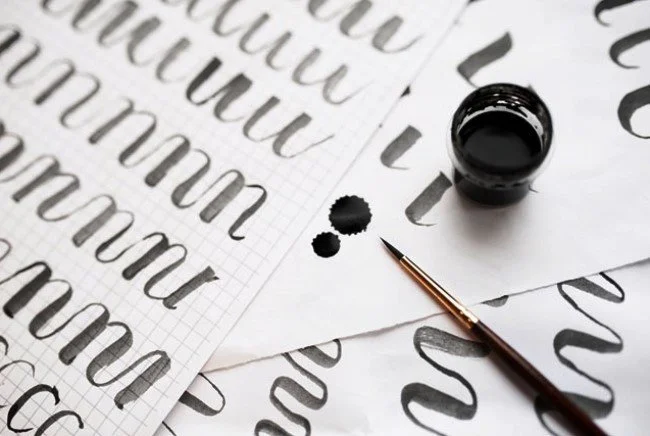The Art of Calligraphy: Exploring the Beauty of Hand Lettering
Calligraphy, the art of beautiful writing, has enchanted generations with its elegance and grace. From ancient manuscripts to modern wedding invitations, calligraphy continues to captivate with its timeless charm. In this article, we'll dive into the captivating world of calligraphy, exploring its rich history, diverse styles, essential tools, and techniques for creating stunning hand-lettered pieces.
A Brief History of Calligraphy: Calligraphy has a storied history, dating back to ancient civilizations like the Egyptians, Greeks, and Romans, who used stylized writing to record important texts and inscriptions. Through the Middle Ages, calligraphy flourished as scribes meticulously crafted manuscripts, illuminated with intricate lettering and decorative motifs.
During the Renaissance, calligraphy experienced a renaissance as artists rediscovered the classical styles of antiquity. The advent of printing technology in the 15th century led to the decline of hand-written manuscripts, but calligraphy endured as a revered art form practiced by skilled scribes and artisans.
In the modern era, calligraphy has seen a resurgence in popularity, fueled by a renewed interest in handcrafted artistry and personal expression. Today, calligraphy enthusiasts can explore a diverse range of styles and techniques, from traditional scripts to contemporary lettering.
Exploring Calligraphy Styles: Calligraphy encompasses a myriad of styles, each characterized by unique letterforms, flourishes, and aesthetic qualities. Some popular calligraphy styles include:
Gothic or Blackletter: Bold and angular, Gothic calligraphy originated in medieval Europe and is often associated with illuminated manuscripts and cathedral architecture.
Italic: Elegant and slanted, Italic calligraphy features flowing strokes and delicate letterforms. It is prized for its simplicity and readability.
Copperplate: Characterized by graceful curves and intricate flourishes, Copperplate calligraphy is ideal for formal writing and invitations.
Uncial: Originating in the 4th century AD, Uncial calligraphy features rounded, open letterforms with minimal flourishes. It has a rustic charm and is often used for decorative purposes.
The Continuing Relevance of Calligraphy: Despite advances in digital technology, calligraphy remains relevant in the modern world for several reasons:
Artistic Expression: Calligraphy offers a unique form of artistic expression, allowing individuals to create personalized and handcrafted artwork that reflects their style and personality.
Cultural Heritage: Calligraphy is deeply rooted in cultural traditions around the world, serving as a tangible link to the past and preserving cultural heritage for future generations.
Special Occasions: Hand-lettered calligraphy adds a touch of elegance and sophistication to special occasions such as weddings, anniversaries, and celebrations. From invitations to place cards, calligraphy enhances the beauty of these memorable events.
Mindfulness and Relaxation: Practicing calligraphy can be a meditative and therapeutic activity, promoting mindfulness and relaxation as individuals focus on the rhythmic movements of the pen and the beauty of the written word.
Essential Tools for Calligraphy: To practice calligraphy effectively, you'll need several essential tools:
Calligraphy Pens: Choose from a variety of calligraphy pens, including dip pens, fountain pens, and brush pens, each offering unique writing characteristics.
Ink: Select high-quality calligraphy ink in a color of your choice, such as black, sepia, or metallic gold. Look for ink that flows smoothly and dries quickly to prevent smudging.
Paper: Use smooth, heavyweight paper or specialty calligraphy paper that is compatible with ink and won't bleed or feather. Experiment with different paper textures and colors for diverse effects.
Guidelines: Guidelines or grid paper can help you maintain consistent letter height, spacing, and slant while practicing calligraphy. Printable guidelines are available online, or you can use a lightbox to create your own.
Where to Get Calligraphy Supplies: Calligraphy supplies can be found at art supply stores, specialty calligraphy shops, and online retailers. Some popular sources for calligraphy supplies include:
Blick Art Materials
Michaels
Paper and Ink Arts
JetPens
Amazon
Professional Calligraphers: If you're looking to commission custom calligraphy work or attend workshops and classes, consider reaching out to professional calligraphers in your area. Many calligraphers offer services such as wedding invitations, envelope addressing, and personalized artwork. You can find local calligraphers through online directories, social media platforms, or by attending calligraphy events and exhibitions.
Calligraphy is a timeless art form that celebrates the beauty of hand-lettered expression. Whether you're a novice or seasoned calligrapher, exploring the diverse styles, essential tools, and techniques of calligraphy can enrich your creative journey. So pick up your pen, unleash your imagination, and let the art of calligraphy inspire you to create something truly extraordinary.




